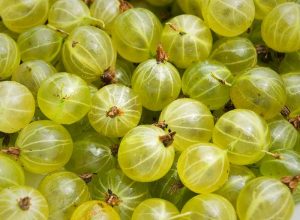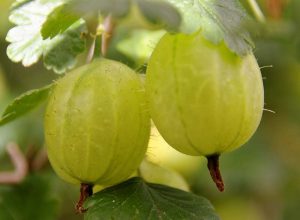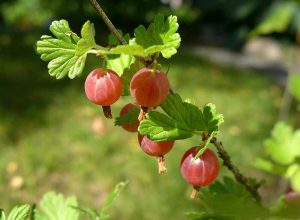Gooseberry


A small deciduous bush which may reach a height of 1.50 metres. The branches are covered in robust thorns, The Gooseberry is certainly a small fruit species, or summer fruit, less intensively cultivated, but we easily find them in small domestic orchards.
Originally from Euro Asia, widespread in Europe Japan and America.
Very resistant to cold winters which are necessary to bring the fruit to maturity. It doesn’t like extremely hot summers: we recommend you plant it in a semi shaded area or rather it should be shielded from strong sun in Summer.
The Gooseberry rarely appears among the other small fruit. Its root system is very superficial and is best cared for by hand (not mechanically) The leaves are covered in a dense fuzz.
TERRAIN
Like almost all berries, even gooseberries like sub-acidic soil with pH 6.0 / 6.5, rich in organic matter; poorly adapts to those of poor fertility or too sandy.


FLORA AND FRUITS
In Spring, usually after the blackberry and redcurrent, along the thorny branches at the base of the leaves and thorns, small solitary flowers appear or grouped in 2 / 3 they are usually in colour and which give way from June to to August, depending of the variety, to berries which compare in size to a grape and are soft green, white and soft red.
The flowers are sensitive to strong winds and late gel of more than a few days. They are self pollinating, however for a better production it is recommended to plant two or more plants together to assist cross pollination. Each plant produces 3 – 4 kgs of fruit, much less with respect to other varieties of Ribes. But, having a more contained vegetation, it’s possible to put down more plants per unit of space: for an excellent development we advise 4 / 6 per 10 square metres.
Varieties of Gooseberry cultivated by PRANDINI’S GARDEN NURSERY
- ROD – Red
- GUL – White (resistente all’oidio)
- UVA SPINA VERDE
USE AND HEALTH GIVING PROPERTIES
With a high content of sugar, the fruit of all the varieties of the gooseberry, at complete maturity are very sweet and don’t have a sour aftertaste as usual with other summer fruit
Best eaten fresh or in fruit salad, but the high content of water means they are not recommended for making jam; they lend themselves well to freezing and they have high contents of anti oxidants, they are rich in vitamins, above all A, B, and C, mineral salts, specifically pectin
Pectin is a indigestible, carbohydrate useful in regulating the intestine, it reduces the concentration of bad cholesterol (LDL) ANDFORMS GOOD CHOLESTEROL (HDL), imprisoning the sugars at intestinal level and lowing the absorption permitting a more stable level of glicermia.
The gooseberry is among the fruit with the highest content of pectin
POTTING PRUNING AND CULTIVATION
The Gooseberry has many vegetative aspects in common with the other ribes, therefore potting is identical.
In winter we recommend removing the old branches to favour the new which could flower in Spring and to render less density to the bush, in Summer you should remove the basic suckers taking care to leave some which will go on to substitute those which were cut down in Winter.
The same as the ribes, even the fertilization: with a semi acid soil, the gooseberry accepts a supply of mature manure in the winter season. Different though is the watering and the cures using pesticides. Having a very superficial root system, watering should be down with attention, being very careful of stagnant water, very dangerous for the gooseberry. Even though is is a robust fruit. Almost all the varieties, especially though with red fruit, are subject to attacks of oidio, a common fungus called white sickness.
To combat this fungus, treat the plant with sulphur: unfortunately for the gooseberry this product is toxic and causes fruit drop from the leaves and stops the growth, that’s why you should follow a treatment with antioidici specifically.
Other funguses which can strike, but very rarely are those provoked by rust and antracnosis. Among the parasites, evn though the attacks are not very frequent you should pay more attention to Sesia ((synanthedon tipuliformis),a black insect with 3 yellow circles on its abdomen, which per sè doesn’t cause problems but the larva digs down the tunnels in the tree causing the death of the original shrub from the Austrian regions, part imminent to the attack of parasites Other insects which can strike the gooseberry are the classic aphids and mites.
Remember that PRANDINI’S GARDEN NURSERY CENTRE is always available to collaborate and advise on the density of the implant, form of rearing, crop choice and assistance, even with plant health for new productive implants even of modest dimensions.
